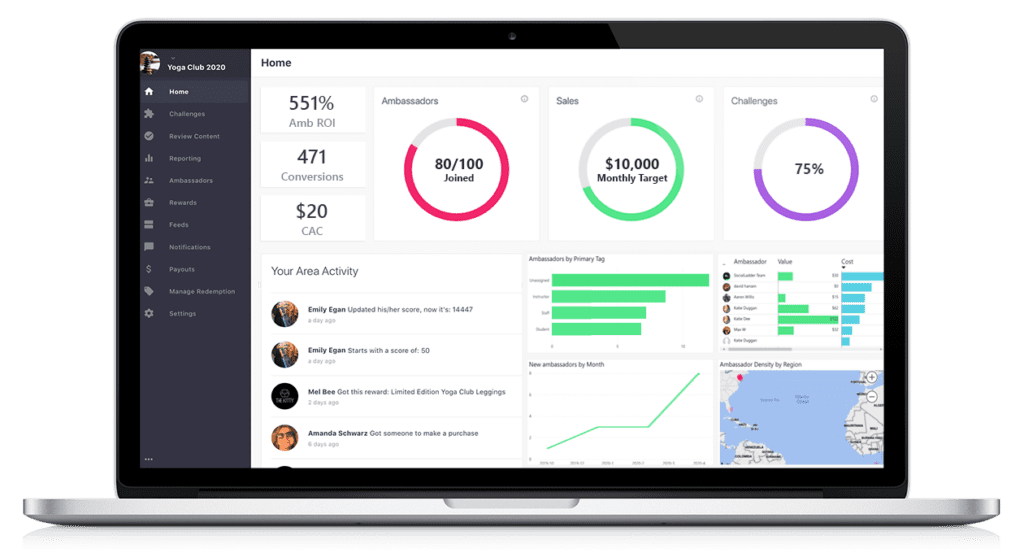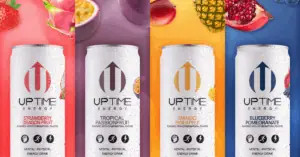Word of mouth marketing (WOM Marketing) is an ideal strategy to both raise brand awareness and engage with your most passionate fans.

Consumers are getting tired of traditional advertising. It wouldn’t be a surprise if you are running AdBlock right now, we don’t blame you. This is a growing sentiment, especially among younger people.
That’s where word-of-mouth marketing (WOM marketing) comes in.
When you recommend a product you like, a movie, restaurant, or anything else, that’s word of mouth.
So you could say word-of-mouth marketing is any effort put into encouraging people to recommend your brand.
This way of getting referrals with the help of your own customers can actually become your lowest cost and most powerful customer acquisition channel.
Why? Because most of the time, a person will buy or do what you recommend.
83% of consumers completely or somewhat trust recommendations from family, colleagues, and friends about products and services – making them the highest-ranked source for trustworthiness.
Word of mouth marketing has always been there, but companies just let it happen on its own instead of creating a strategy to promote it.
In this in-depth guide, you will find the exact definition of word-of-mouth marketing, its benefits, why it’s a good investment, how to start a strategy, manage it and measure it. By the end, you will know what are your next steps no matter the stage of the process you are in.
What is word of mouth marketing?
Benefits of word of mouth marketing
Is word of mouth marketing a good investment?
How to start a word of mouth marketing strategy
What is word of mouth marketing?
First, let’s break down the basics, what exactly is word of mouth?
Word of mouth is when a person shares an opinion about a product or service with another person. In general, word of mouth is unpaid and happens organically.
With that in mind, what is word of mouth marketing?
Word of mouth marketing is any activity from a company that has the purpose of increasing positive word-of-mouth recommendations.
As you can see, WOM is something that happens organically through regular people who just want to recommend an experience. However, there are many things a company can do to encourage it, hence the “marketing.”
Some people also call it word of mouth advertising, but it means the same thing.
As you will later find out, WOM marketing overlaps with other types of marketing because for a user to recommend an experience, it takes a couple of things.
These are some of those things that a brand should do:
- Have an amazing product or service
- Provide a seamless user experience
- Encourage user generated content
- Have a brand ambassador program
- Show reviews of the product/service
Recommended: Word of Mouth Marketing + Strategies
Benefits of word of mouth marketing
Brand awareness
Brands invest large amounts of resources to increase their brand awareness or even to maintain it. Through advertising, content, social media, etc.
This fact is especially relevant for new products. If no one knows you are launching a new product, no one is going to buy it.
It’s clear that brands want their products in front of as many people as possible. But a lot of people looking at a product doesn’t translate into sales.
So the key factor to not waste resources building brand awareness among people outside your market is to target the right demographic.
Word of mouth marketing is great at this because of human relationships.
People relate to others with similar interests and backgrounds, online and offline. Which means that if someone in your target audience recommends your product, it will likely be to another person in your target audience.
Brand trust
Brand trust is another important factor for retaining and converting customers. Marketers know that for a product or service to be successful, people have to trust it. And this applies to advertising as well.
Whether it’s email marketing, social media ads or any other type of advertising, if it looks sketchy, no one is going to trust the brand.
Considering how many scams are out there, it’s for the better that a business has to earn trust from consumers.
Word of mouth marketing solves this issue by spreading your message through trusted faces.
Consumers trust people they know for product recommendations because they are impartial and their intention is to help them.
As opposed to advertisements, where brands are just talking about themselves. People doubt ads because it’s difficult to distinguish true advertising from false advertising.
When someone recommends a product, you know he or she tried it and validates the benefits are true. That brand immediately becomes trustworthy.
Brand loyalty
To have a successful word-of-mouth marketing strategy, you have to improve your community, connect with your customers and increase brand loyalty, especially for DTC (direct to consumer) companies.
Why?
Would you go out of your way to recommend a brand you just like, or a brand you absolutely love?
To achieve that kind of emotional connection with consumers, it will take much more than a good product.
Loyal customers want to see your brand succeed and they will recommend your products every time they can. In addition, most of the time loyal customers are the main source of business for brands.
Is word-of-mouth marketing a good investment?
Now you know what exactly is word of mouth marketing and its benefits, but how effective is it actually?
The best way to demonstrate the effectiveness of word of mouth is with numbers.
- 13% of all consumer sales are a result of word of mouth, that’s $6 trillion in annual consumer spending.
- 74% of consumers say word of mouth was a key influencer in past purchasing decisions.
- 64% of marketers agree that word-of-mouth is the most effective form of marketing.
- Consumers talk about brands casually 90 times per week.
Clearly, people are heavily influenced by what other people have to say about a brand. Another conclusion we can draw from these figures is that people love talking about brands.
Those are the direct effects of word of mouth marketing. However, it also increases awareness, trust, and loyalty, so you also have to take into account those factors to determine the ROI.
How to start a word-of-mouth marketing strategy
With all of that out of the way, it’s time to start planning your word of mouth marketing strategy.
To have a well-defined strategy you first need to think about the following things:
What makes your brand stand out?
Is it your products, your user experience, your esthetic, innovation? Think about your differentiator and make sure it is something people will find unique enough to recommend.
Once you know what makes your brand unique you will understand why someone would recommend your brand above another one.
Who is your audience?
The next thing you need to think about is your audience. Use the data that you have gathered about your customers and see your best-performing markets, demographics, etc.
This might be obvious. However, it’s important to do as much research as possible beforehand to make the most out of your marketing campaign.
What are your goals and KPIs?
By now, you should know your target demographic and what makes you stand out for them. The next step is to define your goals and KPIs (key performance indicators). Do you want to increase brand awareness? Build reputation and trust? Referral sales?
Knowing your goals will help you know what to track and how to track it. This way you can determine your KPIs and know how good your campaign is going.
Later in this guide, we will tell you more about WOM tracking.
Word-of-mouth marketing strategies
Ultimately, a successful word of mouth marketing strategy achieves getting recommended in the most authentic way possible.
Authenticity is key because that’s what people are looking for. Real opinions instead of companies saying how great they are.
So you should keep that in mind for your strategy.
Provide quality products and UX
This should be the first thing a company focuses on to get more recommendations. Sometimes, the product speaks for itself. Using premium materials, ingredients or offering great service will increase your chances of being recommended.
In addition, make sure that not only the product, but the presentation and the packaging are also unique and speak to your target audience. The whole experience should be something to remember.
Just look at Apple. Sure, the products are good, but the design, packaging and esthetics have contributed a lot to the culture that surrounds them nowadays.
The same thing goes for user experience (UX). Optimizing your UX involves taking a look at every interaction a user can have with your company and improving it.
Some things you can do to improve your user experience are:
- Updating your site with a modern design
- Provide fast customer service channels
- Reduce the steps a person has to take to purchase your product or service
User generated content
We could talk about user generated content (UGC) all day. Basically, this type of content is any post, video, story or tweet created by consumers talking about a brand.
UGC usually happens organically when people want to share their opinions online. These opinions give brands validation and credibility just like recommendations. In a way, user generated content is online word of mouth.
Content creators don’t have to be influencers with millions of followers. UGC can be made by anyone, no matter their followers. With this in mind, you should encourage UGC from everyone, even people with small follower counts.
The whole idea of word of mouth marketing is to market through your customers because people’s opinions have a lot of influence on purchasing decisions.
90% of people believe brand recommendations from friends.
That’s why it’s so effective.
In addition, online content opens the door to shares. Meaning that more people with similar backgrounds will look at your brand.
You should expect user generated content to be your main source of referral sales for your word of mouth marketing strategy.
How to encourage user generated content
Interaction. Your WOM marketing strategy should include interacting and engaging with your customers on social media.
The reason is that people like it when brands show that they listen to them and answer back. They will want to talk more knowing you are listening.
Other things you should try:
- Social media contests
- Polls
- Create unique hashtags
- Offer rewards
- Ask fun questions
However, the best way to increase your user generated content production by turning your advocates into ambassadors.
Recommended: Why User Generated Content Should Be Part of Your Social Strategy
Turning advocates into ambassadors
Advocates are loyal customers that want to see your brand succeed almost as much as you do. You can invite these customers to talk about your brand online/offline and reward them with cash payments, products, discounts or commissions. Now they are brand ambassadors.
You are rewarding your fans for spreading your message in a way that still feels authentic to consumers.
By implementing an ambassador program you can control the production of UGC and spark conversations around your brand.
Ambassadors are highly motivated to recommend your products because they:
- Already love them
- Feel like a part of the company
- Get rewards
Brand ambassadors are a key component of WOM marketing strategies because they drive brand awareness, trust, loyalty and referrals while allowing brands to measure their performance.
In addition, since brand ambassadors usually have fewer followers than big influencers, compensation is less expensive, allowing you to build a whole community.
With the help of ambassadors, word of mouth can become your best performing and least expensive growth channel.
Online reviews
Consumer opinions are very important for people when making a purchasing decision. In fact, 89% of consumers try reading reviews when making purchase decisions.
Sounds good, but are reviews actually effective?
According to Hubspot, people trust strangers over advertisements. So the answer is yes.
The data behind that statement is that 70% of people believe consumer opinions, while only 25% accept advertisements as truth.
In addition, a product with 5 reviews is 270% more likely to be purchased than a product with 0 reviews.
That’s a very significant difference.
Online reviews give credibility to brands and greatly influence purchasing decisions. Make sure you ask for feedback and reviews whenever possible to optimize your word of mouth marketing strategy.
Watch out for bad reviews though. Negative consumer opinions are as influential as positive ones. So make sure your product/service meets or exceeds current quality standards before publicly asking everyone for reviews.
How to measure word of mouth marketing
Measuring WOM marketing can be a challenge because it involves online and offline activities.
How do you know if a customer recommended a product to his mom?
Or if someone saw a friend’s Instagram story and purchased a product because of it?
As challenging as it sounds, it’s necessary to track things in order to improve.
A way you can go about this is by measuring the overall brand awareness since the start of your word of mouth marketing strategy. This is not ideal because you won’t get accurate data to know if your strategy is working or if it’s something else. But it can give you an idea.
You can also include a “how did you find us?” space in purchasing orders or ask for feedback after a purchase. This will help you know where your sales are coming from, but you will have to rely on people actually answering.
If you have an ambassador program, then this process is easier. Since they work with the company, they can use tracking links and promo codes. When people click those links or use the unique promo codes, it gets recorded, giving brands accurate data on awareness, traffic and sales directly coming from them.

The bottom line
People love to talk about their purchases and experiences. And those opinions are powerful.
Consumers trust what others have to say about a brand more than advertising. So ensuring that your customers have reasons to speak glowingly about you is a great way to grow organically.
The two best tips we can give you are to make your brand something worth recommending and nurture the relationship with your customers.
This post was updated in 2022



